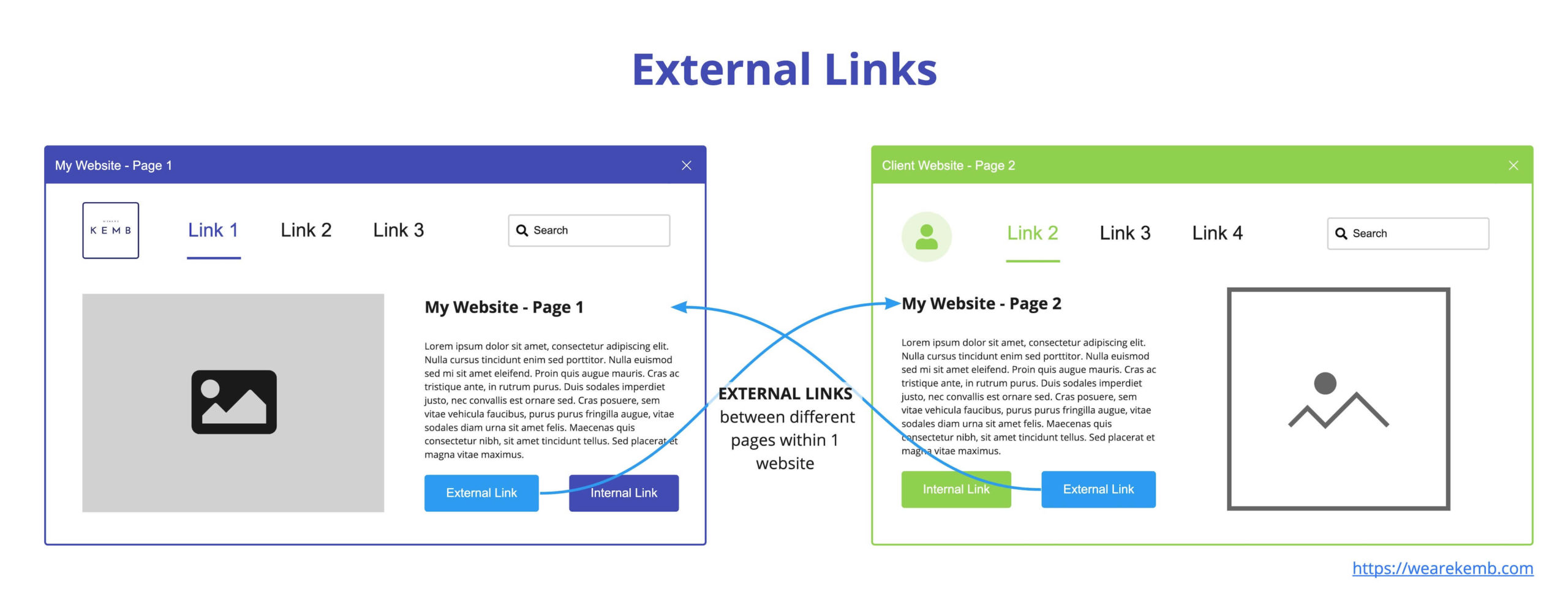Internal Linking for SEO: An introduction and a plea
When it comes to link strategies, most people immediately think of backlinks, i.e. external links that lead to your website from other, preferably relevant sources. But without devaluing backlinks, in this article we would like to focus on internal links, because those are quite often underestimated. We will show what the value of internal links is and why especially internal links are not only particularly useful for Google (and thus for your SEO strategy), but also offer great value for website users. As a UX factor, they support a great structuring of your website and help improve the user experience during a visit significantly. We’ll show you how!
Table of Contents
What are internal links?
Internal links are all the links within your website or, strictly speaking, within a given domain. Starting with the links of your website navigation to the links stored in the footer up to all connections from one content piece to the other, e.g. within a text to another page, all of these are considered internal links.

What are external links?
An external link is any link that leads from one domain to another domain. Please note the explicit distinction between domains. I.e. even if you are the owner of the linking domain, this is considered by google as an external link.

What is the function of internal links?
1. Internal links create a hierarchical structure of your website architecture. What does that mean? Internal hyperlinks ensure that an unsorted sum of individual pages is turned into a (ideally) well-structured network. They put the content available on your domain in relation to each other, creating an order to the entire website. Whether by linking main topics of the same level from your homepage ( typically elements of your navigation), but also by linking main categories to subcategories, articles to related topics or even category pages to product pages, as is common in a webshop, for example.
2. Internal links help users to better navigate on your website. It should go without saying that a logical structure of your website architecture isn’t an end in itself. First and foremost, users should of course be able to move through your site as smoothly as possible. Not only should all content be accessible in just a few clicks, but related information in particular must be linked together in a way that is easy for users to follow. In this way, you ensure the most seamless onsite experience possible. This naturally starts with the site navigation, which is used to link to your site’s most important elements. It continues, however, especially when we take a closer look at individual pages: it is important to ensure that a particular page X always links to the information (pages Y, Z) that offers the greatest added value for a user at exactly this point in the user journey, i.e. that could represent the most obvious next steps.
It is therefore these two factors that make internal links so valuable: for search engines and their crawlers, but also for your website visitors. The better you succeed in satisfying both, the greater the benefit to your SEO performance.

Why internal links are so important for SEO?
As already indicated, the structure of your internal linking gives search engines and their crawlers an overall picture of the paths along which your site was built. The clearer this structure and the shorter the click paths required to get from the top (your homepage) to the content that branches out deepest down the page structure, the easier for search engine crawlers to pick up on your content. This makes internal links an important ranking factor.
1. All of your pages that you want to show your audience should be easily found by your visitors and must therefore also be easily accessible for crawlers.
A page that is very deeply integrated into the website structure and, for example, is only linked to via a detour through various subcategories, will possibly only be found with difficulty or not at all when your website is crawled. Anything that cannot be found by crawlers may not appear as a result in search engines. At worst, it means a page won’t be indexed at all. Therefore, when creating new content pieces/pages, always make sure that you embed and link it in a meaningful way into the existing structure on the website and that click paths do not go too deep.
Hint: Always aim to find a balance between a hierarchy that is as flat as possible (i.e. low click depth) and a sorting along central categories that makes sense in terms of your content. We would recommend trying to keep your clickdepth below 5. Meaning you can reach every page within your website within 5 clicks. A meaningful structure follows two logical steps in particular: on the one hand, it separates thematically different topics from each other on a horizontal level, and on the other hand, the path (on a vertical level of linking) leads from general to specific. This can be well illustrated by an example.
Let’s assume you want to position yourself as an expert in setting up e-commerce store systems. You offer support for various types of store systems, say WooCommerce, Jimdo and Shopify. On your website, the three categories would be sorted equally on one level. For google this would result in the following picture:

In a next step, further sub-topics should now be mapped logically according to those main categories.

Thus, in such a basic setup of the page already, a logical order of content is taken into account, which is accordingly reflected in the linking. All further content, be it specific services that you offer in one of those niches or related articles that you publish on one of those sub-topics: it can be sorted into the relevant category accordingly. Another example: Let’s assume you run a blog on your website. At the start of your content creation, you may have published two, three, or maybe even ten different articles. All of these articles are just stored in a folder you call “Blog” and which in turn is directly linked to your homepage (home/blog/).
Now suppose you continue to work on that blog, and with each new article you may find more opportunities to link to already existing content. And it is quite possible that at one point you cover certain topics very comprehensively if you have created a great deal of content. The better these articles are interlinked, the more likely you will receive good rankings for this whole topic. Since each of these links represents a new “chapter” to you talking about a certain topic. So you should always keep in mind that it needs to be easy for users as well as for crawlers to find all of those chapters. It starts with just linking to relevant further articles and at some point, it can even make sense to establish a specific subfolder in your blog for the respective topic area. This way, not only do you develop the clean structuring of your website content, but you also build a link structure which makes it easy for Google crawlers to immediately recognize a topical network as such. And this leads to our next point.
2. Internal links are important signals for Google to assess the relevance of different content on your website.
A simple example: An e-commerce shop that sells apparel has about 50,000 different products. Every single product has an individual URL, which in turn is linked to a parent category (pants, shoes, tshirts, etc.). Now let’s assume that this webshop has more than 2000 pairs of different shoes, but only about 100 different t-shirts in stock. So when scanning the website, google registers 2000 links to a category called “shoes” versus only about 5% of links to a category that is “tshirts”. Which of the two categories is sending stronger ranking signals to the search engine? We will spare ourselves the answer at this point.
The example illustrates the value of internal links in two ways: On the one hand, it shows how simple and clear structures are created through internal links. And how these enable easier crawling for search engines. After all, an appropriate page structure already ensures that 2000 related products can be found when crawling the upper category. On the other hand, every single link from such a product to its parent category, i.e. every new pair of shoes that has its own page and is assigned accordingly, sends an additional signal to search engines. And that signal is: our store is well equipped in this area. In other words, it has established a certain authority when it comes to “shoes”. We stay in the picture to name another positive side effect that you should not overlook because its benefit is at least as important. That is, the top category “shoes” passes on part of its authority to each new page. Such a phenomenon is often referred to as “linkjuice”.




